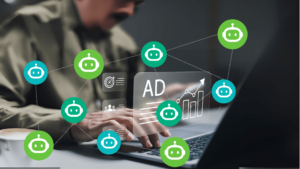A.I. in marketing has sparked both enthusiasm and skepticism. While it’s true that A.I. won’t fulfil all its promises overnight, it’s equally clear that A.I. is a transformative macro trend. Just as driverless cars were predicted to be a year away ten years ago and still aren’t mainstream, A.I.’s evolution and integration into marketing will take time. Yet, the impact of generative A.I. on writing and translation over the past few years is undeniable. To navigate what’s next, it’s essential to understand where we currently stand. Here are five common misconceptions about A.I. in marketing:
1. “A.I. has been around for years; this recent hype is just noise!”
This is a significant misconception. While it’s true that A.I. has existed for decades, with Alan Turing’s Turing Test in the 1950s and the rise of machine learning in the 60s, the A.I. of today is vastly more advanced. The A.I. technologies we use now are orders of magnitude more sophisticated than those of a decade ago. The launch of generative A.I. in November 2022 marked a new era, making A.I. tools accessible to hundreds of millions of people worldwide. This isn’t just hype; it’s a revolutionary leap forward.
2. “Generative A.I. can answer questions accurately”
This is a dangerous misconception. Generative A.I. has revolutionised how machines mimic human outputs and create content. However, it doesn’t truly understand the concepts behind the content it generates. For example, it can struggle with puzzles that require a deep understanding of context, like the river crossing puzzle. This means that any output from A.I., no matter how convincing it appears, must be extensively fact-checked. When using Generative A.I. for marketing data analysis it’s crucial to validate the results before taking action to avoid potential pitfalls.
3. “All AI is the same”
Recognising the different types of A.I. is crucial. AI can be broadly categorised into:
- Specific A.I. vs. General A.I.: Specific AIs are designed to solve particular problems, such as language translation or playing chess. General A.I., or Artificial General Intelligence (A.G.I.), aims to solve any problem like a human can. A.G.I. does not yet exist and is likely still far off.
- Machine Learning vs. Generative A.I.: Machine Learning is commonly used for data analysis, while generative AI focuses on mimicking human creativity, such as writing or art. These types of A.I. serve different purposes and should be used accordingly.
4. “A.I. is going to take my job!”
This fear, though common, is not entirely grounded. Economist Richard Baldwin highlighted that “A.I. won’t take your job. It’s someone using A.I. that will take your job.” The best approach for those worried about A.I. is to embrace it to enhance their productivity. A.I. can automate repetitive tasks, freeing up individuals to focus on strategic and creative work. With an ageing population and a shrinking workforce, A.I. is unlikely to cause widespread unemployment. Instead, by embracing A.I., we can leverage it to improve productivity and create a better world.
5. “A.I. is just for tech companies or engineers”
A.I. is for everyone. With hundreds of millions of users already using ChatGPT within months of it launching we can see that, in this new era, A.I. is for the many, not the few. As this era develops, all businesses, in every category, will need to adapt A.I. techniques to compete and indeed to talk with their customers in the manner they expect. Further, the use of A.I. techniques is not just for engineers, but for most if not all marketers, as these tools provide a huge boost to productivity and effectiveness.
In summary, while skepticism is healthy, understanding the true capabilities and limitations of A.I. can help us harness its potential effectively in marketing.



